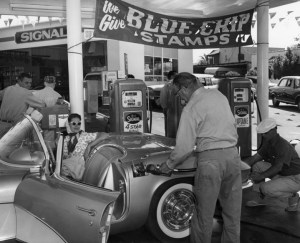 Gaylord Nelson, Democratic Senator from Wisconsin, originated the first Earth Day in 1970. (Also born in 1970 was Paul Ryan, an Ayn Rand acolyte elected to Congress by Wisconsin voters in 1998.) Nelson wanted a “national teach-in on the environment.” Pete McCloskey, a Republican Congressman, from California, served as Nelson’s co-chair. What are the chances today of a Democrat and a Republican coming together on environmental issues?
Gaylord Nelson, Democratic Senator from Wisconsin, originated the first Earth Day in 1970. (Also born in 1970 was Paul Ryan, an Ayn Rand acolyte elected to Congress by Wisconsin voters in 1998.) Nelson wanted a “national teach-in on the environment.” Pete McCloskey, a Republican Congressman, from California, served as Nelson’s co-chair. What are the chances today of a Democrat and a Republican coming together on environmental issues?
Twenty-million Americans demonstrated on April 22, 1970, sending a message  that it was time to address the deterioration of the air, the water and the land. Later that year, President Richard Nixon issued an executive order creating the Environmental Protection Agency. Congress soon after ratified the order. Nixon – yes, that Richard Nixon – also signed the Clean Air Act, the Safe Drinking Water Act and the Endangered Species Act.
that it was time to address the deterioration of the air, the water and the land. Later that year, President Richard Nixon issued an executive order creating the Environmental Protection Agency. Congress soon after ratified the order. Nixon – yes, that Richard Nixon – also signed the Clean Air Act, the Safe Drinking Water Act and the Endangered Species Act.
Forty-seven years later, flanked by coal-company executives, coal miners and the  vice-president, along with various administration flunkies, Donald Trump signed an executive order rescinding his predecessor’s “Clean Power Plan.” Just to rub the EPA’s nose in it, the president held the signing ceremony inside the agency’s offices. He finished by telling the deluded coal miners, “C’mon, fellas. You know what this is? You know what this says? You’re going back to work.” According to the Associated Press, renewable-energy jobs already outnumber coal jobs, and many renewable-energy technologies are on their way to being cheaper than coal.
vice-president, along with various administration flunkies, Donald Trump signed an executive order rescinding his predecessor’s “Clean Power Plan.” Just to rub the EPA’s nose in it, the president held the signing ceremony inside the agency’s offices. He finished by telling the deluded coal miners, “C’mon, fellas. You know what this is? You know what this says? You’re going back to work.” According to the Associated Press, renewable-energy jobs already outnumber coal jobs, and many renewable-energy technologies are on their way to being cheaper than coal.
Obama’s executive order was a plan to reduce carbon emissions. Trump’s EO lifts a moratorium on new coal mining leases on federal land and relaxes limits on new coal power plant construction.
I wonder what our children and grandchildren will think about this.
…and in other news…
In a lawsuit filed against Palm Beach County, Trump demanded $100 million damages, alleging that emissions from the jets flying overhead are “causing substantial destruction of the materials” used to build the club, which include unique and historical items like “porous Dorian stone, antique Spanish tiles and antique Cuban roof tiles.”
And if that wasn’t bad enough, the suit claims noise and fumes from the air traffic have “substantially deprived” Trump and the club’s members the ability to use the property’s outdoor areas and amenities.










